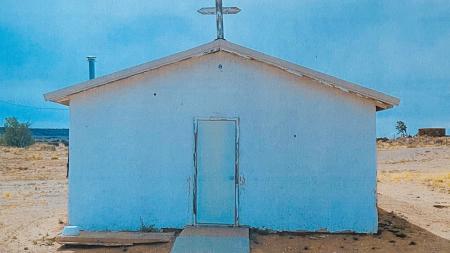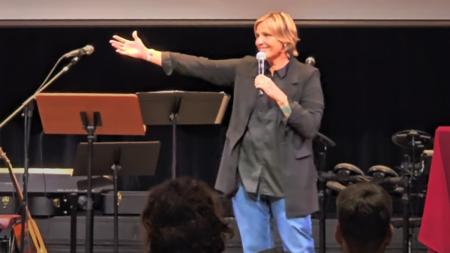Vancouver Church Reaches Young People

First CRC of Vancouver was built in 1948
First Christian Reformed Church near downtown Vancouver, British Columbia is a tidy, white-brick building, built in 1948 by veterans who immigrated to Canada from Holland after World War II.
At first the church thrived. A photograph in the foyer, taken at a church picnic in 1953, shows hundreds of men, women and children.
But by the late 1950s it began experiencing a steady decline. In the coming decades, First CRC would face many of the challenges outlined in a report that describes the changes and issues now confronting the Christian Reformed Church in North America.
The report, compiled by the CRC's Strategic Planning and Adaptive Change Team (SPACT), is part of a process leading to the creation of a new ministry plan for the denomination.
Among other things, the report notes that immigration to Canada, once largely from Europe, is now mostly from Asia; that the average age of CRC members is rising; that weekly attendance is down, and loyalty to the denomination is in decline.
While the report describes many of the challenges congregations face, it doesn’t spell out how they should adapt to the changes and challenges. Nor does it describe what churches like First CRC mean to their members.
“I love this church. For me, it is all about community. There are a lot of young adults and that makes it easier to come here,” says Trixie Ling, 30, a project manager for a Vancouver mental health agency.
After its heyday in the 1950s, First CRC lost members. Young families began drifting away and members who remained got older.
Some churches finding themselves in that situation have shut their doors. But First CRC took another path, deciding it needed to seek a new identity.
Around the year 2002, it started to focus more attention on the community in which it found itself. Students from nearby Regent College were living in the large houses, now turned into apartments, in which former church members had raised their families.
After discussions and prayer, the church launched a mentorship program, using Regent students to work with urban youth. That program, and then others, paid off.
Students got connected to the church and some began showing up on Sunday. Young people attracted other young people.
Now, on Sunday mornings, a number of young families, as well as college students, fill the pews, together with middle-aged and long-time members.
Ling was recently elected as an elder in the church, a sign, she says, that First CRC wants someone young and female to be in a position of authority.
“I am very hopeful. I can have a voice in the future role of the church. I won't be talking from the sidelines," she says.
Dena Nicolai, 29, planned to attend a meeting that was coming up at Willoughby CRC for Vancouver-area congregations interested in learning about and commenting on the SPACT report.
She said she hoped to address issues described in the report, such as the need to find ways to keep younger people in the church.
She says her church attracts young people because of its involvement in social justice issues.
First CRC, for instance, was closely involved in a recent Truth and Reconciliation Commission meeting held in Vancouver.
Members of the church attended that meeting, at which the commission heard testimony from aboriginal people describing what it had been like to live in church-sanctioned boarding schools. During the meeting, First CRC pledged its support to the aboriginal people of Canada.
"We want to see our church speak up on important issues," said Nicolai, a student in the Master of Theological Studies program at Regent College.
Both Nicolai and Ling said their church has a heart for people such as the mentally ill. The church planned in coming weeks to hold a gathering for mentally ill persons and advocates to discuss their issues.
First CRC has also been very supportive in having the Canadian government build a large welcoming center for refugees on land next to the church.
In addition, it provides a community meal on Wednesday evening to neighbors, and offers what it calls a sustainable living group, in which church members share ideas on how to live simply, generously and justly as stewards of the earth.
"The main question for the future is ‘What is the role of the church in the community?’ We can’t stay static,” Ling says. “We need to change.”
At one time First CRC’s church community and the neighborhood itself was mainly Dutch and European immigrants. But that isn’t the case anymore, and for that he is grateful, says Frank Kuipers.
Kuipers didn’t attend First CRC when that 1953 picture of the church picnic was taken. But he could have. He’s in his 80s now and came to Canada from the Netherlands. He’s been to several CRC congregations, many of them predominantly Dutch.
As he thinks back over the decades, Kuiper says that in his experience the CRC was a denomination whose ministers gave very little room for any kind of disagreement or discussion among church members.
Kuipers said he remembers as a child in the Netherlands throwing snowballs at a minister he and his friends did not like. They found him to be cruel and the gospel he preached to be strong on doctrine but lacking love.
He said many preachers today, such as Rev. Trevor Vanderveen of First CRC, are different, and that is what drew him to First CRC.
"He (Vanderveen) is not like the old ones. He tells us what we need and the people love to hear what he has to say," said Kuipers.


